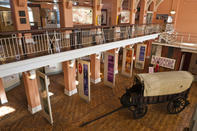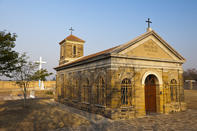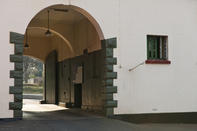Voortrekker Museum
Despite its overwhelmingly British colonial character, Pietermaritzburg's history is intimately linked to that of the Voortrekkers, who settled here in 1838 after the Battle of Blood River. The Dutch-speaking Voortrekkers moved into Natal from the Cape and laid out a town between the Umsunduzi River and the Dorp Spruit (‘town stream’).

The Voortrekkers named the settlement ‘Pieter Mauritz Burg’ after a man named Pieter Mauritz Retief, who led the first trek into Natal, as the province was called in early years. In 1938, it was decided to honour the leader of the second trek, Gert Maritz and the name was changed to Pietermaritzburg.
Among the buildings relating to the Voortrekkers are the Voortrekker Museum, Voortrekker House - the only surviving double-storey Voortrekker house in Pietermaritzburg, dating back to 1846 - and Welverdiend, the house of trek leader Andries Pretorius.
The main building of the Voortrekker Museum houses a variety of cultural-history exhibitions which are constantly upgraded and expanded. The Museum also boasts a replica Hindu Shiva temple and a beautiful herb garden.
Italian Prisoner of War Church

The Italian Prisoner Of War Church was built near the end of the Second World War by Italian prisoners in Pietermaritzburg. It was sanctified in 1944 but was then neglected after the war.
Vagrants since used the church until it was later ruined by a fire. Eventually it was restored thanks to funding from the Italian consulate, and it was then declared a national monument in 1977 after which it was donated to the Pietermaritzburg City Council.
Eventually the deed to the church was given to one of the original Italian builders of the church. The Italian government provided funding for further restoration and there has been talk about moving the Italian Military Cemetery closer to the church, as well as building a memorial museum on the premises to honour and remember the Italian prisoners of war.
Macrorie House

Macrorie House in Pietermaritzburg is the only early to mid-Victorian double-storey house open to the public in town. It is both a national monument and a heritage site. Built around 1860, the house was rented in 1870 by the Bishop of Maritzburg, William Kenneth Macrorie. The Bishop went on to buy the house and named it South Hill.
Today it is filled with authentic Victorian furniture, and a visit through the museum will give you incredible insight into the days of yore, as well as introduce you to the stories and romance of the late 1880s and 1890s. The tour includes at least one ghost story (the ghost of the local jailer's wife is said to roam the corridors).
Macrorie House also includes the personal belongings and memorabilia of the bishop. It presents the lifestyle of the early British settlers in this part of the world, particularly the life of a man of the church – the house includes a private chapel with an altarpiece from England.
The museum holds an annual Victorian Fair and is also open for tea in the garden.
The Old Prison

The Old Prison building in Pietermaritzburg is an official heritage site and within its walls lies a national monument, as well as a museum documenting South Africa’s history.
The prison has seen more than 150 years of history and housed prisoners through all of the country’s turbulent times - through colonial times, apartheid, the liberation struggle, and the eventual transition from apartheid to democracy. The prison was commissioned in 1859 and officially opened in 1862.
The first cell block to be built was Cell block E, which is now a national monument. It is one of the oldest buildings in Pietermaritzburg. Each cell of the prison was designed to hold an individual prisoner, but as numbers increased, 10 to 12 people were put in one cell. A gallows and cookhouse were later constructed, with prisoners dining outside in any and all weather conditions.
Over the years, prisoners of different races were kept separate. The prison saw many political prisoners and freedom fighters detained at some point, including notable figures such as Nelson Mandela, Alan Paton, John Langalibelele Dube, Albert Luthuli and Mohandas (Mahatma) Gandhi. Eventually, the prison was closed in 1989 due to overcrowding, and in 1991 Project Gateway was given permission to use the building for community development projects. Tours of the Old Prison are open to the public but must be arranged in advance.